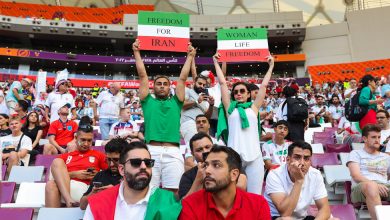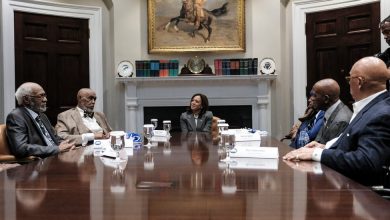At Indian Wells, a Shot of Optimism for American Men’s Tennis

INDIAN WELLS, Calif. — False dawns in American men’s tennis? There have been quite a few in the last 20 years here in the California desert and in more well-watered parts of the pro circuit.
So, it is unquestionably wise not to get carried away in a sport the Europeans still rule, as they have since a smooth-moving Swiss man named Roger Federer calmed his nerves and slipped into a higher gear in 2004 to leave Andy Roddick in his rearview mirror at the top of the rankings.
Since then, tall and good-natured American men in the shadows, like John Isner and Sam Querrey, have had to field countless variations of one question: “What has happened to American men’s tennis?”
But Isner, 36, long the top-ranked American man, had a look of quiet confidence on Tuesday night as he revisited that topic.
“I think for the first time in a while you can actually say American tennis on the men’s side is very promising,” he said. “There’s no doubt about that.”
How not to detect a cool breeze of optimism after watching Tommy Paul, 24, knock out the third-seeded Alexander Zverev in a third-set tiebreaker here at the BNP Paribas Open on Sunday night and then seeing the 21-year-old Californian Jenson Brooksby outhit and outwit the fifth-seeded Stefanos Tsitsipas in another three-set upset the following night?
Indian Wells, a second home to many an affluent elder, has been prime real estate for coming of age this year, and that does not even include the 21-year-old American Sebastian Korda’s missed opportunity against Rafael Nadal in the second round. Korda, the younger brother of the L.P.G.A. stars Nelly and Jessica, was up two service breaks and 5-2 in the final set before allowing Nadal, one of the game’s greats, to wriggle free.
Even without Korda, four American men have reached the round of 16 here: Isner, Brooksby, Taylor Fritz and Reilly Opelka, the 6-foot-11 power server with a bushy beard and swing speed worthy of a lumberjack. That is the most since 2004, and it also reflects their rise in the ATP rankings. The seven American men in the top 50 is also the most since 2004, and six of those seven men — all but Isner — are under 25.
It is no takeover: The top 10 remains nearly all European, with Felix Auger-Aliassime of Canada as the lone interloper. But it is progress, and there appears to be considerable upside.
“I think that’s true,” said Patrick McEnroe, an ESPN analyst, former pro player and U.S. Davis Cup captain. “I think particularly from Opelka, Brooksby, Korda and maybe throw Fritz in there, although I don’t know if he’s got the athleticism to get to the top-top.”
McEnroe, like a lot of people in tennis, looks at the 18-year-old Spaniard Carlos Alcaraz, with his blazing speed and all-action, all-court game, and clearly sees a future No. 1 player.
“I wouldn’t say that about the Americans,” McEnroe said. “But I would say, to me, I could see Brooksby, Korda and Opelka definitely hitting the top five at some point and definitely getting to the final four or final of a major. That’s what it’s going to take to get the average fan a little bit more interested in it, no doubt. So, I’m very optimistic, and if you have one or two of those guys do that, I think the other guys will feel even more emboldened.”
For now, the Americans have a daunting Wednesday ahead with Opelka facing Nadal, Brooksby facing the defending tournament champion Cameron Norrie, Fritz facing the No. 29 seed Alex de Minaur, and Isner facing the No. 33 seed Grigor Dimitrov.
This has been a long time building, and McEnroe had a view near the ground floor as the head of the United States Tennis Association’s player development program. He was pushed out in late 2014 in part because of poor men’s tour results. When his tenure ended, Isner was the only American man ranked in the top 50, but while in his role, McEnroe heard and saw plenty of Opelka, Paul, Fritz and Frances Tiafoe, a charismatic African American player from the Washington, D.C., area.
All four are projected to be ranked in the top 40 after this tournament, with Opelka currently the top-ranked American at No. 17.
“It’s cool that we can all do this together,” said Fritz, who is ranked 20th, after his narrow third-round victory over the Spanish qualifier Jaume Munar on Tuesday.
They are fast friends. Boyhood group photos abound, and Opelka and Paul were long housemates in Florida. Like many groups of talented players from the same country, they are feeding off each other and pushing each other.
“It’s really not surprising,” Fritz said. “I’ve been around these guys my whole life. I know how good they are.”
Fritz, Opelka and Paul were all Grand Slam tournament junior singles champions, which is not necessarily a harbinger of professional success, although it certainly was for Federer, who won the Wimbledon boys’ title in 1998.
But the Americans have all made it on tour. Trailing them in age, but not potential, are Korda and Brooksby, both 21 years old but with very different games.
Korda is the 6-foot-5 son of Peter Korda, the 1998 Australian Open winner, and the retired WTA player Regina Rajchrtova. He has a flowing, balanced game with easy power, and his emotions, by design, are difficult to read on his placid game face.
Brooksby is a fiery 6-foot-4 scrapper from Sacramento with an underpowered serve who has not been on tennis experts’ radar nearly as long as Korda has. His style is confrontational, and his strokes are artisanal. But his contact points are consistently clean, and his two-handed backhand is a versatile marvel — and he can punch and counterpunch with conviction with his forehand, too.
“He’s a little bit unconventional in his ball-striking, but the space between a foot or two behind the ball and a foot or two in front of the ball, he repeats that over and over again,” said Brad Stine, Paul’s coach. “Would I teach someone to hit a ball exactly the way he hits the ball? No. But it’s absolutely, 100 percent repeatable for him.”
Stine compares Brooksby to the former top-five player Brad Gilbert, an author of the book “Winning Ugly.” Brooksby has repeatedly left higher-ranked players mystified and disgruntled during his brief and successful professional career. Add Tsitsipas, the hirsute Greek with the polished game and elegant one-handed backhand, to that list, as he damned Brooksby with faint praise (in defeat).
“He’s not a very explosive player, but he’s able to get balls back,” Tsitsipas sniffed. “He’s not the most athletic player, as well. He’s just able to read the game well, play with his pace, play with the opponents’ pace.”
“There’s nothing that he has that kills, I would say,” Tsitsipas concluded.
But Brooksby seemed far from miffed. “I think a lot of players and coaches maybe don’t see how I could be as good of a level as I am,” he said. “That’s what we shoot for in our games and strategy, not to be too easily figured out. That’s how the top players over history have been.”
For now, Brooksby is ranked 43rd. The top spot, occupied by Daniil Medvedev of Russia and soon to be reoccupied by Serbia’s Novak Djokovic, is a long way off. It remains highly advisable to keep the Champagne in the fridge with young talents like Alcaraz and Italy’s Jannik Sinner already well-established threats, but the Americans and the collective mood are justifiably upbeat.
Even Isner did not seem to mind answering yet another question about the future on Tuesday: What would it take for us to say American men’s tennis is really back? A Slam title?
“No, because the bar has been set pretty low since 2003, probably,” Isner said. “I think getting two guys in the top 10 would be a good starting point. Then you go from there.”
That, in Isner’s mind, “in the near future is very conceivable.”





